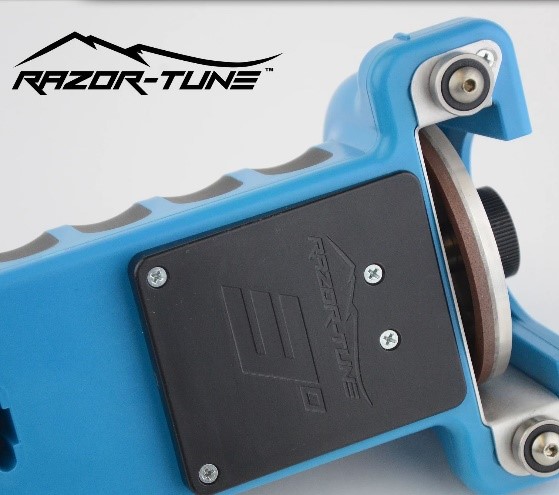It’s that time of year again. Winter is approaching (or already started) and if you’re the parent of one more ski racers, or a ski racer yourself, you can expect to spend many hours over the coming months in a tuning room or garage filing, waxing, and scraping ski after ski after ski after ski till the snow finally melts.
As the father of two ski racers, I can speak to this yearly ritual firsthand. Though both of my daughters are learning how to tune their own skis, I still take responsibility for getting their new skis tuned to start the season.
I’m certainly no stranger to tuning skis. I have distant memories of tuning my skis from my racing days at Burke Mountain Academy, Middlebury College, and the University of Colorado (as well as my two years on the pro tour). Files and stones were the tools of the trade back then. I then took a decades-long break from ski tuning when, though I still skied often, I usually brought my skis into a shop to be tuned a few times a year.
Then, I had two children who, as they grew up, developed such a love for skiing and then ski racing that they have chosen, at least for the time being, to pursue this crazy and most difficult sport of ours. A big upside for me is that I get to live in the mountains while they attend Sugar Bowl Academy in Northern California. The downside had been that I was spending more and more time in our tuning room in our cabin on Donner Summit, which meant less time with my family and doing other things that I actually love to do (though, admittedly, I do enjoy tuning skis).
With late fall camps beginning in a few weeks, my recent weekends have been devoted to tuning the 10 pairs of skis (yikes!) that my daughters will be using this winter. Thankfully, I’ve discovered a tool that has made my life as a ski technician vastly easier, less time consuming, yet more effective. First, some back story.
Interestingly, tuning skis hasn’t changed that much in the many decades since I was a racer. It’s still about sharp edges and smooth and fast bases. And many of the tools are the same, including files, stones, and scrapers, though much more expensive. And wax has gotten more sophisticated and, OMG!, incredibly expensive (no, it doesn’t make a difference before FIS, so save your $$$!).
But one thing has changed that has made my life, and the lives of many ski-tuning parents and racers, much easier. As with many aspects of our modern-day lives, technology has evolved that not only results in better prepared skis, but also accomplishes that outcome in much less time.
A few years around this time, I wasn’t too thrilled about spending another winter and countless hours tuning skis the old-school way, with a file and stone. So, I began to do some research on power tuning devices. I read an article on skiracing.com that reviewed some of the popular devices. I had seen national team technicians use them for many years, but never thought that I would have a need or an interest myself. But, as I read the article, my first reaction was that I had to “git me one of them new-fangled gizmos!” (said with a Vermont accent). My second reaction was sticker shock, as I saw how much these gizmos cost, in the $1000-$3000 range. Far beyond my pay grade however much I wanted one. So, I resigned myself to continuing to tune my daughters’ skis the old-fashioned way.
The skiracing.com article produced many comments from readers, one of whom mentioned a new power ski-sharpening tool called the Razor-Tune which she raved about (as did several other commenters) and called it idiot-proof (that was a prerequisite for me!). And the best part, beyond the very positive reviews, was the price, starting at $500 for the basic kit. Now that was a price point I could wrap my wallet around!
I decided to call up the owner, Troy Scriven (try doing that with one of the other power tuners!), an inventor and a father whose children were racers, to learn more about the Razor-Tune. He was familiar with my work in the psychology of ski racing and so, after talking for a while, he said he would send me a unit to try out.
Well, the Razor-Tune blew me away from the start. I learned that the Razor-Tune has one big design advantage. Many of the other power ski tuners are placed on the edge with the base vertical, meaning that they sit rather precariously on the sidewall and can easily slip off and grind the edge the wrong way. But the Razor-Tune sits across the base with the base facing up, providing a stable platform and a solid feel.
There are several benefits to this design. First, it is nearly impossible for the Razor-Tune to slip off and ruin an edge (again, idiot-proof!). Second, you don’t need a vise to hold the ski in place while using the Razor-Tune; you can use it in the parking lot, a hotel room, anywhere really. And, Razor-Tune now offers a battery accessary that you can mount on the unit, so you can be entirely cordless in your tuning room or anywhere else you might need to add some hum to skis.
When I first tried the Razor-Tune, I was so afraid of running the edges, I decided to start on my own last year’s SL skis because I wanted to get some practice before I tried it on my daughters’ race skis. I read the directions and watched the instructional video and then I dove right in. I felt a bit awkward at first as I got a feel for the Razor-Tune. But within 15 minutes, I felt like “Chief,” the long-time World Cup technician whom I had gotten to know when I worked with Team America a few years ago. Admittedly, of course, I only felt like him, but the results were still remarkable in three ways.
First, the edges were far sharper than anything I did using a file and stone. Second, in the past, it would take me upwards of 20 minutes to sharpen a pair of skis. But with the Razor-Tune, I had a pair of skis incredibly sharp in less than five minutes. Third, it was easy to get comfortable with using the Razor-Tune and the icing on the cake was that I didn’t screw up and ruin any skis. In fact, the Razor-Tune is so easy to use, my daughters have learned how to use it and are now mostly responsible for tuning their own skis this winter. In fact, after a season-opening tune, they don’t allow me to work on their skis anymore (admittedly, a disappointment to me). Thanks to the Razor-Tune, they have become very skilled in tuning their own skis. In contract, it takes years to become truly adept at sharpening skis with a file and stone.
Our family has been using the Razor-Tune for two years now and I can’t imagine ever going back to files for sharpening my daughters’ skis (or mine or my wife’s). Every time we sharpen a pair of skis with the Razor-Tine, I’m amazed at how sharp they are. And the Razor-Tune has proven itself to be a quality product that has stood the test of 100s of pairs of skis so far with no sign of slowing down. The grinding wheels also have plenty of mojo left in them.
So, if you want to get your kids’ skis razor sharp this winter, or even better, if you want your kids to get their own skis razor sharp, in much less time, then I recommend that you run to your computer and order a Razor-Tune. I promise that your spouse and children will thank you. And you’ll also thank yourself because you’ll have so much more time to devote to what really matters in your ski racing family: Watching your kids having fun and gaining the many wonderful benefits of our sport.
Note: This article is an updated version of an article I published last year.







